 |
||
|
||
| ||
Well, after you have read the title you might ask us "why do you pay so much attention to the VIA company, and especially to their not very successful Cyrix processors, which are not the Cyrix at all, and even hardly work?" Actually, we are going to look into it. Especially considering that there is the sound ground for it - the release of the Samuel 2 processor which extends Samuel core based VIA processors working at 533 and 550 MHz. The article will start with words on the company VIA. So, VIA, a prominent manufacturer and the strongest competitor against Intel on the market of chipsets for mainboards, set about promotion of the acquired processor work-outs and aims at conquering up to 10% market of these processors. You might call it nonsense. There is not only Intel, the whole Low-End sector of the processor market is occupied by the cheapest and high-efficiency solution from AMD with the Duron name! But in fact it's not that bad. Right now VIA has bright perspectives since they are not burdened with factories. The same factories that cost billions dollars and which should be updated continuously according to the non-stop improvement of technological processes. Besides, the clumsy giants Intel and AMD have to produce on their the most modern factories only High-End processors, and to invest the income into modernization of their works. That's why in the nearest half a year the processors Celeron and Duron wouldn't undergo any changes - they will be still based on the 0.18 micron technology. But there is such a monster of the Taiwanese semiconductor industry TSMC (Taiwan Semiconductor Manufacturing Company) that offers their services to VIA; their two factories work on the 0.15 micron technology. 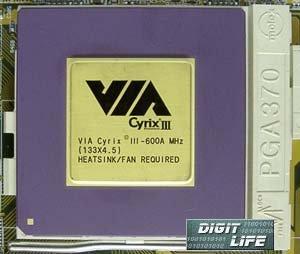 It's exactly the latest technological process that distinguishes the Samuel 2 based processors from the Samuel based ones. Now the VIA processor is based on the most perspective technology what allows tremendous reducing the die's size to 52 sq mm against 75 sq mm of the processor with the Samuel core and 90 sq mm of the Celeron processors with a new core C0. The 0.15 micron technology process makes possible an easy increase of the clock speed of the processor, what VIA is going to implement little by little, considerably reduced supply voltage and energy consumption. Let's start with the clock speed. The processor VIA Cyrix III Samuel works from 500 to 667 MHz. Despite the quite long 12-stage pipeline which in theory should allow overclocking of the 0.18 micron processor up to 1 GHz and higher, the tested processors poorly endured overclocking, and not because of the overheating - the temp of the heatsink never exceeded 40 degrees C. The tested 550 MHz processor, intended for 100 MHz FSB, managed only 5,5 X 112 = 616 MHz, what hardly can be called satisfactory. The Samuel 2 processors will work from 700 MHz (according to the roadmap from VIA) and should quickly reach 900 MHz, and by the Q2 2001 we will see a new core EZRA, and the 0.13 micron process will have been polished - well, for VIA the tomorrow seems quite rainbow. Today we can say only that VIA will easily go through the increase of the clock speed for their processors than the competitors in the Low End sector. In the nearest time the Low-End processors from Intel and AMD might have uneasy life… Of course not in performance, but in the clock speed; and this is a huge step forward. Especially from the marketing point of view. The second important issue is the power consumption. At 1.5 V the 700 MHz processor with the Samuel 2 core takes only 5 W, what is less than even a mobile version of the processor Celeron that works at 600 MHz. The following diagram shows power consumption of the processors:  For comparison - the usual (not mobile) 600 MHz Celeron takes 17 W, while the 600 MHz Duron - 24,5 W. The dissipated power constitutes around 70-80% of the consumed one. Dissipated power shows how much heat must be taken away by the cooling device. According to the figures we can assume that the Samuel 2 won't need even a heatsink. And if the VIA Cyrix III processors with the Samuel worked without a heatsink, the Samuel 2 works wonders. Our processor was operating during 24 hours without a heatsink and a fan. When working in ordinary mode in business applications the core kept the room temperature, with the business tests it warmed up a little, and only with the Quake3 we felt that it really could get hot. The processor reached 50 degrees C without any cooling, and no sooner had we switched off the applications it got cold immediately. And at last, the most interesting thing. The 52 sq mm core managed to house a L2 cache measuring 64 KBytes, which should contribute the performance gain. Here you can see a table supplied by the VIA company:
We had two Samuel 2 processors in our lab, one of them was a development type with the 667 MHz frequency, and the other - a pre-production one working at 600 MHz. The core of the both processors was marked C5B. You might ask why the frequencies start not from 700 MHz? These processors were released in small lots, specially for a preliminary estimation of the performance of the future systems, and at the time of commercial shipping the frequency will be exactly 700 MHz and higher. The both processors are packed in a ceramic case and the core is covered with a metallic lid which not only protect the core but also serves as a heatsink. The marking of the new processors is implemented in the style of the Celeron. The Celeron processors with the same clock speed, e.g. 300 MHz but differing in the presence/absence of the L2-cache were marked as the 300A and the 300. Now the company VIA marks the Samuel 2 with 600 MHz and 64 KBytes L2-cache as the Cyrix III 600A. The Samuel 2 will sell under the trade mark Cyrix III, like its predecessor. But since this name hasn't justifies the hopes, the large letters Cyrix now will be replaced by the large VIA, and next to it you can see small letters Cyrix III.  The new processors Samuel 2 are promoted with the help of Gigabyte. That's why for testing the new processor we have taken the Gigabyte 6VX7-4X motherboard with the update version of BIOS from Award which identifies the L2-cache. Despite the fact that the processors are not serial samples, they both are shipping with locked multipliers and are intended for 133 MHz of the FSB. Quite scanty set of the GA-6VX7-4X frequencies didn't allow estimating their overclocking possibilities, though there is still something to say. The 600 MHz processor with the multiplier equal to 4.5 managed to work at 150 MHz - 675 MHz totally. The 667 MHz couldn't cope with 150 x 5 - 750 MHz - it refused to pass the POST that's why we could reach only 140 x 5 = 700 MHz. The overclockability is not impressive, so we hope that the series models would show greater results. PerformanceThe following testbed was used to estimate the performance:
Software:
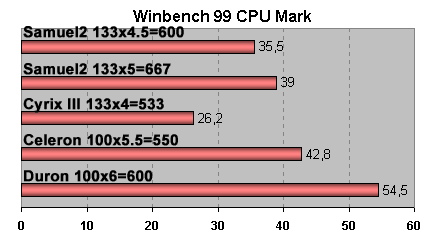 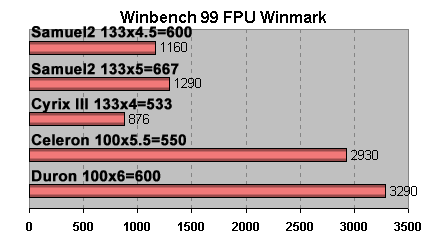 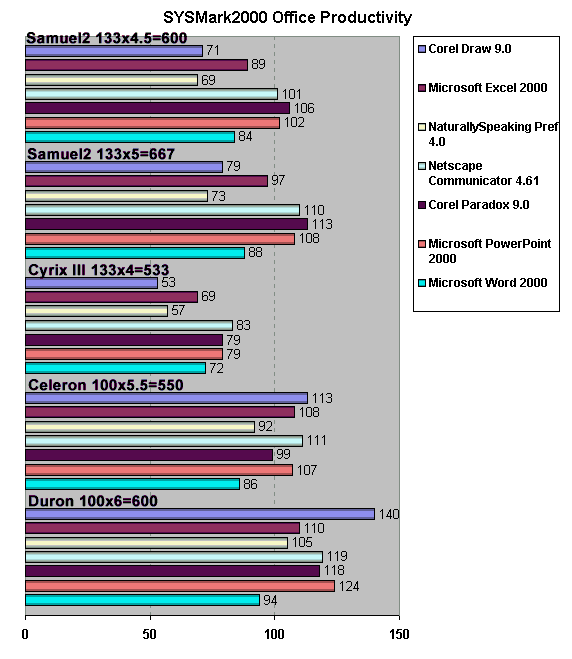   Well, the Samuel 2 performed rather well - the higher clock speed and the additional L2-cache allow the processor to run with confidence in business applications. The same L2-cache allowed to brighten up the situation in game applications. The following diagram shows a noticeable increase in performance of the 667 MHz processor on the Gigabyte 6VX7-4X as compared with the motherboard Epox 3VCA2+ brought in with the BIOS optimization for the L2-cache of the new processor. 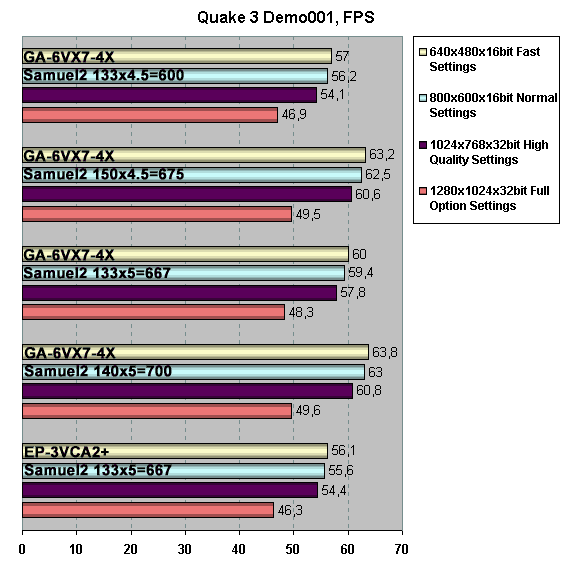 Nevertheless, the main disadvantage of the Cyrix III with "A" letter is a slow co-processor. The diagram above shows the results received while overclocking of the Samuel 2 processors - but in this case the main increase in performance was achieved mainly thanks to the bandwidth of the bus "processor-memory". That's why the strongest side of these VIA processors is a usage of the 133 MHz mainboard. I hope that soon we will able to see other architectural advantages, with the improved coprocessor among them. Besides, we should notice that the both processors - 600 and 667 MHz - provide not just acceptable but even comfortable game possibilities. With the competent price policy, the Samuel 2 can really gain its own market part - it has taken all the advantages of its predecessor and has increased the performance. High:
Lows:
PS The author has ordered a Micro-ATX case with
the fan-lacking power supply unit for 135 W, and with the help of
the processor Samuel 2 he is going to assemble environmentally appropriate,
practically noiseless system case for comfortable writing of reviews
- in silence.
Write a comment below. No registration needed!
|
Platform · Video · Multimedia · Mobile · Other || About us & Privacy policy · Twitter · Facebook Copyright © Byrds Research & Publishing, Ltd., 1997–2011. All rights reserved. |